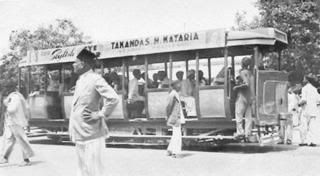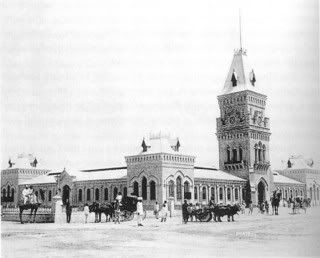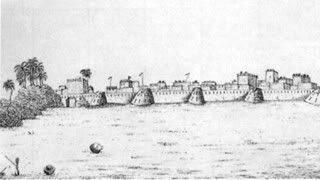Karachi has a wonderful history that is neither discussed nor celebrated as much as the history of Mughal Lahore (see ATP post here). As we saw from the earlier ATP post on ‘whistling’ in Karachi (here), there is much interest in this, certainly from me. As someone who grew up in Karachi, the most I was taught about its history revolved around the history of its name (derived from the town of Mai Kolachi) and that the Venetian gothic style buildings were remnants of the British cantonments and Karachi’s short-lived existence as the capital city of Pakistan. (See some historical video footage of Karachi on ATP here).
Well, now I feel I know a bit more about my city, its rich history, and the architectural heritage that still stands impressively (despite languishing in neglect for decades). For that, I thank a wonderful website titled “The Story of Karachi“, which I was introduced to by the folks at the Karachi Metroblogs. Judging by its guestbook logs, the website has been in operation since mid 2005, but it seems it only recently become well known to the internet dwellers.
The simplicity of the narration deserves praise and clearly the material is organized such that it can continue to evolve almost as a wiki project. The photographs are simply awesome. Check it out.
I will try to cite a few interesting items from the website here, which I am sure many Karachiites would find fascinating, but would also be of interest to a broader audience:
- Karachi’s is said to have been known as Barbarikon during the Indo-Greek Kingdom. That town became Kolachi jo goth when an old fisher woman by the name of Mai Kolachi settled there, and the town eventually came to be known as Karachi.
- Kharadar and Meethadar areas are the sites of two gates of a fortress that was built near the village of Kolachi near Manora by the Talpura Amirs in the pre-19th century history.
The Talpura Amirs erected a small fort at Manora near the village, which had some cannons brought in from Muscat. The fort had two doorways: one facing the sea known as Khaara Darwaaza (Brackish gate) and the other facing the Lyari river known as Meetha Darwaaza (Sweet gate).
- Karachi officially became a part of the British empire in 1843, which is also the year when the city got linked to Multan via river transport . That led to a significant growth in population
On February 1st, 1839, a British ship, the Wellesley, anchored off the island of Manora. By 3rd February, the fort at Kolachi had surrendered without firing a single shot and this small fishing village crossed a turning point in its life. Three years later in 1843, upon the annexation of Sindh into the British empire, the regional capital was transferred from Hyderabad to Karachi by Charles Napier, the first governor of Sindh. The British made the town an Army Headquarters and military cantonments were established outside the town limits.
In 1843, a river steamer service was introduced linking Karachi with the city of Multan, 500 miles upstream on the Indus. The population of the city started rising rapidly and by the 1850’s, Karachi had become an established city with a population of about 14,000 and prosperous overseas trade.
Soon, moneyed people from Bombay, Goa, Kuchh and other parts of the subcontinent started migrating to the city to undertake various occupations. The town’s population started rising rapidly which is evidenced by the fact that the municipality’s income rose from Rs. 6,000 in 1848, to Rs. 27,000 by 1850 in just two years.
- In 1861, Karachi got its first railway connection (to Kotri), and the trade of cotton began to prosper due to the shortage caused by American civil war. In 1864, direct telegraph connection was introduced and the harbor & port were modernized to allow Karachi to become an important full-fledged sea port for India.
ÂÂÂ

- It was also during this time that several monumental buildings such as the Frere Hall, Sindh Club, St. Patrick’s Cathedral & School, Merewether Tower (now simply known as ‘tower‘ to the bus conductors) and the Gymkhana were built.
- Towards the end of the ninteenth century, the relationship between Lahore and Karachi were firmly established: Lahore as an agricultural hub, and Karachi as the main port for goods from Lahore. In many ways that relationship continues to this day.
The 1890’s saw the emergence of the Punjab as the granary of India and Karachi was the region’s principal outlet. This brought many business opportunities to Karachi and the population of the city expanded. Consequently, revenues of the city also increased and public works projects were undertaken on a grand scale. Boulton Market was built in 1883, and in 1890, the grand Empress Market was constructed to commemorate the Silver Jubilee of Queen Victoria’s reign. This monumental structure with a clock tower was designed to compete with the Crawford Market of Bombay and was designed to be 12 feet higher. The market quickly gained a position in the city’s center. Hospitals such as the Civil Hospital and the Lady Dufferin Hospital were also inaugurated.
 It was in early 1900s that the area now known as Bunder Road, Burns Road, Elphinston Street, and Preedy Street became crowded commercial areas, with traffic building to the point that a tram had to be introduced from Saddar to Keemari. I wish we still had trams in Karachi. Not least for aesthetics, but also because of the hazards we have now created with the bus -dependent public transportation system.
It was in early 1900s that the area now known as Bunder Road, Burns Road, Elphinston Street, and Preedy Street became crowded commercial areas, with traffic building to the point that a tram had to be introduced from Saddar to Keemari. I wish we still had trams in Karachi. Not least for aesthetics, but also because of the hazards we have now created with the bus -dependent public transportation system.
By 1891, statistics showed a population of about 105,000 and by the time the 19th century drew to a close, Karachi had 117,000 inhabitants as of 1901. Karachi had become one of the biggest and best outfitted ports of the world.
- It seems that the air travel arrived in Karachi around 1927, and the location of the first airport was exactly where today’s Jinnah international Airport now stands. During the second world war, the airport served to house airforce planes as well.
In 1924, an aerodrome was built and Karachi became the main airport of entry to India. The British Government also developed an Imperial Airship Communications Scheme in the 1920’s, which was a plan to have a fleet of large dirigibles providing mail and passenger service to far-flung portions of the Empire. A site was located outside Karachi and construction of an airship mast, hangar and a hydrogen plant was begun in 1927. Although, this program was cancelled after the destruction of the Airship R 101 in 1930 with great loss of life, the shed and the mast remained as impressive relics of the plan till well after Pakistan’s independence. They were later dismantled and the steel was used for buildings and bridges along the Pakistan Railways. The site later became the international airport at Karachi.
- Karachi became the capital of the province in 1936, and of course the capital of the newly created state of Pakistan in 1947. It remained in that position until 1958, when Islamabad was created.
In 1947, independence was finally granted to the subcontinent and Pakistan came into being as a new country made by the partition of British India. Karachi became the capital city and premier port of the newly formed state. It was the most built up city in Pakistan at the time and accommodated a huge influx of migrants to the newly formed state, which made it expand at a rapid rate. Pakistan’s first civil and military bureaucracy was housed in the city and Karachi served as the capital city of Pakistan until 1958 when a new capital was made at Islamabad.
What happened to Karachi after 1958 is a mixed bag of positives and negatives. Federal resourced shifted away from the city and the businesses could not keep up what the government neglected. I am too young to know what Karachi was like in the 60’s and 70’s but from what I hear, it was still an exciting place, at least until after Bhutto was hanged. The shutdown of the Hotel Taj and the ambitious Casino project in Clifton are reminders of what could have been. Ethnic strife took hold in the 80’s and only recently has the politics settled just enough to allow for some alternative voices to be heard.

Today Karachi is struggling to find its place as the liveliest city in Pakistan. It now has a population greater than 12 million (according to 2006 estimate) and the City District is now divided into eighteen towns governed by elected municipal administrations. Karachi is the financial capital of Pakistan, a hustling bustling metropolitan mega city with its rich mix of cultures, races, and religions.
It is estimated to generate approximately 65% percent of the national revenue but somehow the state of the city’s streets, markets, architecture and landscape does not indicate so. The streets are crowded, noisy and polluted, and we all know what happens when it rains in the city. The infrastructure of this cosmopolitan city is struggling to keep up with the demands of a growing population while the administration falters. It is unfortunate sight that the majestic buildings of the past are now coated with soot, hidden behind ads of aamil najoomis or stifled in the glare of neon lights. The few remaining reminders of Karachi’s diversity of the past include Christian missionary schools or educational institutions setup by the Parsi community.
The fortunate thing is that the city has withstood some very troubled times, and always seems to bounce back. The Niharis, Haleem, Behari Kebab, and the Biryanis seem to occupy people’s minds fast. When all else fails, Clifton beach is still there for some serenity. I know I can always count on it!





















































I’ve been exploring CBD or THC products: cornbread thc gummies an eye to a while, and this article in fact resonated with my own experience. CBD has helped me discontinuance cool-headed, snore well-advised, and control burden in a straight habit without that heavy or “foggy” feeling. I’ve tried oils, gummies, and full-spectrum blends each works differently depending on the moment. The timbre for me was consistency and quality: in the good old days I switched to natural, lab-tested brands, the results became more noticeable. It’s not a necromancy medicament, but it can be a genuine support after loony make up for and fuselage recovery.
Ontdek alle functies op meer info over Kokobet. De website is gebruiksvriendelijk en maakt het eenvoudig om te beginnen.
https://confiafarmacia.com/# Viagra generico online Espana
Cialis generika günstig kaufen: cialis 20mg preis – Cialis Preisvergleich Deutschland